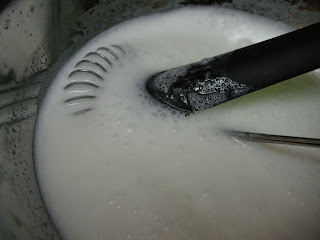My interest started when I saw an image of a fluffy sugar scrub that didn´t look like what I was using at all.
Mine didn´t hold together long enough to take a picture unless it´s on a spoon. How could this be? I started reading about it further and little by little, I learned about an emulsified sugar scrub. I started here:
http://swiftcraftymonkey.blogspot.com.es/2013/01/facial-scrubs-emulsified-scrubs.html
I´ve been using an oil with sugar scrub for months and love how my skin feels afterwards. It´s a different story for the sink and tub however; I´ve even slipped while trying to exfoliate my heal while standing (that was silly of me). Well, that´s in the past now ever since I´ve started using this emulsified sugar scrub. An important ingredient is an emulsifying wax (E-wax) which is commonly used in making lotions and creams in order to keep the oils and water from separating. So imagine having the E-wax in the sugar scrub. Once you start rubbing the sugar concoction onto wet skin, it creates lotion! Bye, bye to oily tub residue, and say hello to well hydrated skin without the need for lotion application after the shower.
The recipe I used is adapted from http://www.soapalooza.com
620 grams olive oil
100 grams coconut oil
50 grams shea butter
100 grams e-wax (Polawax)
80 grams stearic acid
50 grams beeswax
2 kilos white sugar
20 grams fragrance oil (honeydew melon)
10 grams preservative (Sharomix)
Why the glass bowl? It helps cool the batter and it´s easier to see if the mixing is thorough enough.
Once the bowl feels warm to the touch (below 50ºC), add the scent, skin-safe colorant (if using) and preservative. I used a bit of green food coloring to match the honeydew melon fragrance oil. The final product is pourable at this point to get it into jars. It will firm up some more so that if you tilt the jar, the dough will not budge but pliable enough to grab some to take with you to the shower.
Mine didn´t hold together long enough to take a picture unless it´s on a spoon. How could this be? I started reading about it further and little by little, I learned about an emulsified sugar scrub. I started here:
http://swiftcraftymonkey.blogspot.com.es/2013/01/facial-scrubs-emulsified-scrubs.html
I´ve been using an oil with sugar scrub for months and love how my skin feels afterwards. It´s a different story for the sink and tub however; I´ve even slipped while trying to exfoliate my heal while standing (that was silly of me). Well, that´s in the past now ever since I´ve started using this emulsified sugar scrub. An important ingredient is an emulsifying wax (E-wax) which is commonly used in making lotions and creams in order to keep the oils and water from separating. So imagine having the E-wax in the sugar scrub. Once you start rubbing the sugar concoction onto wet skin, it creates lotion! Bye, bye to oily tub residue, and say hello to well hydrated skin without the need for lotion application after the shower.
The recipe I used is adapted from http://www.soapalooza.com
620 grams olive oil
100 grams coconut oil
50 grams shea butter
100 grams e-wax (Polawax)
80 grams stearic acid
50 grams beeswax
2 kilos white sugar
20 grams fragrance oil (honeydew melon)
10 grams preservative (Sharomix)
 |
| Heat the oils, butter, both waxes and stearic acid on low until completely dissolved. |
 | |
| Pour into a heat-proof glass bowl with the sugar and stir well. |
Why the glass bowl? It helps cool the batter and it´s easier to see if the mixing is thorough enough.
Once the bowl feels warm to the touch (below 50ºC), add the scent, skin-safe colorant (if using) and preservative. I used a bit of green food coloring to match the honeydew melon fragrance oil. The final product is pourable at this point to get it into jars. It will firm up some more so that if you tilt the jar, the dough will not budge but pliable enough to grab some to take with you to the shower.
































